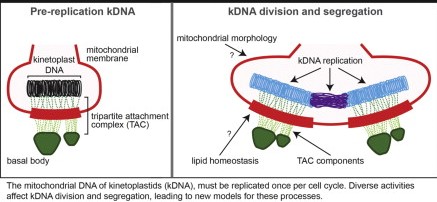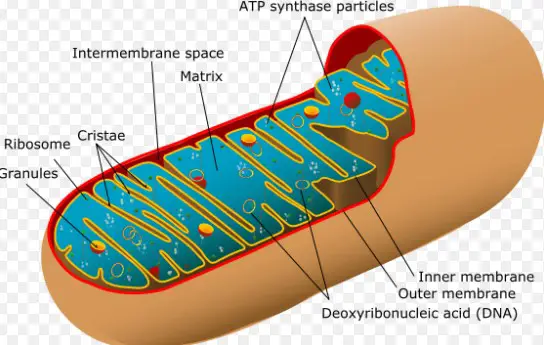Cellular organelles play pivotal roles in the life of a cell, orchestrating a myriad of biochemical processes that sustain life. Among these, mitochondria and kinetoplasts stand out due to their unique functionalities and structural characteristics. While both are energy powerhouses for cells, their differences extend beyond their primary function, touching upon aspects of genetics, evolution, and disease involvement.
The difference between mitochondria and kinetoplasts lies primarily in their structure, genetic material, and the organisms they are found in. Mitochondria are ubiquitous in almost all eukaryotic cells, known for their role in ATP production through cellular respiration. Kinetoplasts, on the other hand, are a specialized form of mitochondria found in trypanosomatids, characterized by their unique DNA structure and involvement in parasitic diseases.
Mitochondria are enveloped by a double membrane, contain their own circular DNA, and are crucial for energy production, calcium signaling, and apoptotic processes. Kinetoplasts also contain DNA, but in a complex network called kDNA, and play a key role in the metabolism and survival of parasitic protozoans. Their unique attributes make them subjects of intense study, not only to understand their biological roles but also to explore therapeutic targets against diseases they are implicated in.

Basic Structure
Mitochondria Features
Description and Function
Mitochondria are organelles found in nearly all eukaryotic cells, recognized as the energy powerhouses of the cell. They are responsible for producing adenosine triphosphate (ATP), the cell’s energy currency, through a process known as oxidative phosphorylation. Beyond energy production, mitochondria play crucial roles in cellular signaling, cellular differentiation, cell death, as well as the control of the cell cycle and cell growth.
Membrane Structure
Mitochondria are characterized by their unique double-membrane structure. The outer membrane covers the organelle and contains porins that allow the movement of ions and molecules. The inner membrane is folded into cristae, increasing its surface area to enhance ATP production. Between these membranes is the intermembrane space, and inside the inner membrane is the mitochondrial matrix, where the mitochondrial DNA (mtDNA) and enzymes important for oxidation of metabolites and ATP synthesis are found.
Kinetoplast Features
Unique Characteristics
The kinetoplast, a specialized structure found in the mitochondria of trypanosomatids, like the Trypanosoma species, displays unique characteristics. It houses a large mass of DNA (kDNA) organized into a single, highly interconnected network. This DNA is essential for the organelle’s function and survival of the protozoan.
Relation to Mitochondria
While a form of mitochondrion, kinetoplasts distinguish themselves through their DNA organization and function within parasitic protozoans. Their existence underscores the evolutionary diversity of mitochondrial DNA across different species and highlights their specialized adaptation to the parasitic lifestyle.
Genetic Material
Mitochondrial DNA
Circular DNA
Mitochondrial DNA (mtDNA) is notable for its circular form, similar to bacterial DNA, reflecting the mitochondria’s evolutionary origins. This DNA contains genes crucial for the mitochondrion’s function, particularly in the production of proteins necessary for oxidative phosphorylation.
Gene Content
The mtDNA encodes for about 37 genes, which include 13 proteins involved in electron transport and ATP synthesis, 22 tRNAs, and 2 rRNAs. This limited gene set is supplemented by nuclear DNA-encoded proteins, which are transported into the mitochondria to fulfill various functions.
Kinetoplast DNA
Network of DNA
Kinetoplast DNA (kDNA) is highly structured, forming a complex called a maxicircle and minicircles network. Maxicircles are analogous to mitochondrial DNA, encoding rRNAs and essential mitochondrial proteins, while minicircles encode guide RNAs that edit the mRNA produced by maxicircles.
Comparison with Mitochondrial DNA
Unlike the simpler circular mtDNA, kDNA’s network structure is unique and complex. This complexity is vital for the trypanosomatids’ survival and adaptability, reflecting a significant evolutionary divergence from the more familiar mitochondrial DNA structure found in other eukaryotes.
Energy Production
Role in Metabolism
Mitochondrial Function in ATP Synthesis
Mitochondria are crucial for metabolic processes, converting nutrients into ATP via the citric acid cycle and oxidative phosphorylation. They utilize oxygen to break down food molecules, releasing energy to synthesize ATP from adenosine diphosphate (ADP) and inorganic phosphate.
Kinetoplast’s Role in Energy Generation
Kinetoplasts, while structurally distinct, similarly support energy production in parasitic protozoans. They enable these organisms to efficiently generate ATP, crucial for their survival and virulence, especially within host environments.
Differences in Process
Variations in Metabolic Pathways
The metabolic pathways of mitochondria and kinetoplasts differ significantly, reflecting their adaptation to various environmental conditions and host organisms. Mitochondria support a wide range of metabolic functions in multicellular organisms, including humans. In contrast, kinetoplasts are adapted for parasitic existence, often exploiting unique metabolic pathways to survive and proliferate within their hosts.
Distribution in Cells
Mitochondria Presence
Mitochondria are ubiquitous across eukaryotic cells, from humans to plants and fungi. This universality underscores their essential role in energy production, calcium signaling, and regulation of cell death. Their presence in such a wide array of organisms highlights their critical function in cellular metabolism and the evolutionary advantage they provide.
Ubiquitous in Eukaryotic Cells
Found in almost every type of eukaryotic cell, mitochondria’s versatility allows them to adapt to various cellular environments and energy demands. Their number within a cell can vary greatly, from a single large mitochondrion in some algae to thousands in muscle cells, reflecting the energy requirements of the host cell.
Inheritance Patterns
Mitochondria have a unique maternal inheritance pattern in many species, including humans. This means they are inherited almost exclusively from the mother, a feature that has become a cornerstone in studying evolutionary biology and diseases.
Kinetoplast Localization
Kinetoplasts, unlike mitochondria, are specific to trypanosomatids—a group of protozoa that includes several parasitic species responsible for diseases like sleeping sickness and Chagas disease. This specificity makes the kinetoplast a key feature in the biology and pathogenicity of these organisms.
Specific to Trypanosomatids
Found only in trypanosomatids, kinetoplasts reflect a significant adaptation to parasitic life. Their unique DNA configuration is essential for the organism’s survival and adaptation to different hosts.
Impact on Cell Function
The kinetoplast plays a crucial role in the cell’s metabolic processes, particularly in energy production. Its structure and function are intricately linked to the parasite’s ability to infect hosts and evade their immune responses.
Evolutionary Significance
Mitochondrial Evolution
The evolution of mitochondria is a fascinating chapter in the history of life on Earth. Their origin is tied to a pivotal event in evolutionary history known as the endosymbiotic theory.
Endosymbiotic Theory
This theory suggests that mitochondria originated from a symbiotic relationship between an early eukaryotic cell and a prokaryotic cell. Over time, the prokaryote became a permanent resident within the host cell, evolving into the mitochondria we know today.
Evolutionary Adaptations
Mitochondria have undergone significant adaptations throughout evolution. These include the development of the double membrane and the transfer of some of their genes to the nuclear genome of the host cell, a process that has streamlined their function and integration into the cellular machinery.
Kinetoplast Evolution
Kinetoplasts represent a remarkable evolutionary adaptation within trypanosomatids, enabling these organisms to thrive as parasites.
Origins and Adaptation
The origin of kinetoplasts is linked to the evolution of trypanosomatids themselves. Their unique DNA structure has evolved to support the complex life cycles of these parasites, allowing them to adapt to various environments and host organisms.
Significance in Parasitology
The kinetoplast’s evolutionary journey offers valuable insights into the mechanisms of parasitism and survival. Its study is crucial for understanding how parasites adapt to their hosts and develop resistance to treatments.
Role in Disease
Mitochondrial Disorders
Mitochondrial disorders are a group of conditions that occur due to malfunctions in mitochondrial function. These diseases can have profound effects on health, affecting the neurological system, muscles, and other vital organs.
Common Diseases
Diseases such as Leber’s hereditary optic neuropathy (LHON), mitochondrial myopathy, and neurodegeneration are linked to mitochondrial dysfunction. These conditions often result from mutations in mitochondrial DNA or genes in the nuclear DNA encoding mitochondrial components.
Impact on Health
The impact of mitochondrial disorders on health can be severe, leading to decreased life expectancy, chronic fatigue, and progressive muscle weakness. The energy-dependent nature of organs like the brain and muscles makes them particularly vulnerable to mitochondrial dysfunctions.
Kinetoplast and Pathogenicity
Kinetoplast DNA plays a pivotal role in the pathogenicity of trypanosomatids, with significant implications for tropical diseases.
Association with Tropical Diseases
Kinetoplastids are responsible for several tropical diseases, including sleeping sickness and Chagas disease. These diseases pose significant public health challenges in affected regions, with substantial morbidity and mortality rates.
Challenges in Treatment
The unique biology of kinetoplastids, including their kinetoplast DNA, contributes to the challenges in treating diseases they cause. Their ability to rapidly evolve resistance to drugs complicates efforts to develop effective treatments.
Frequently Asked Questions
What is a kinetoplast?
A kinetoplast is a type of mitochondrion found in certain parasitic protozoans, such as those belonging to the Trypanosomatidae family. It contains a unique structure of mitochondrial DNA, organized into a densely packed network called kDNA. This organelle is essential for the cell’s energy production and is closely linked to the parasite’s virulence and drug resistance mechanisms.
How do mitochondria and kinetoplasts differ in DNA structure?
Mitochondria typically contain circular DNA molecules that are relatively simple in structure. In contrast, kinetoplast DNA is complex, forming a tightly interlinked network of thousands of circular DNA molecules. This network structure is unique to kinetoplasts and plays a critical role in their function and regulation within parasitic protozoans.
Why are mitochondria called the powerhouses of the cell?
Mitochondria are referred to as the powerhouses of the cell because they are the primary site for ATP production, which is the energy currency of the cell. Through a process known as oxidative phosphorylation, mitochondria convert nutrients into ATP, providing the energy needed for various cellular processes and functions.
Can mitochondrial diseases be treated?
Treatment options for mitochondrial diseases are currently limited and often focus on managing symptoms and slowing progression rather than curing the disease. However, research into mitochondrial biology and genetics is ongoing, and it holds promise for developing more effective treatments, including gene therapy and targeted medications.
Conclusion
Mitochondria and kinetoplasts, though sharing the fundamental function of energy production, exhibit profound differences in structure, genetic makeup, and biological roles within cells. These distinctions not only underscore the diversity of life at the cellular level but also highlight the complexity of evolutionary adaptations across different organisms. Understanding these differences enriches our knowledge of cellular biology and paves the way for advancements in medical science, especially in the treatment of mitochondrial diseases and parasitic infections.
The exploration of these organelles continues to be a vibrant field of study, revealing new insights into the life of cells and offering hope for innovative therapeutic strategies. As research progresses, the intricate details of how mitochondria and kinetoplasts operate, evolve, and impact health and disease are expected to become even clearer, further demonstrating the marvels of the cellular world and its significance to human health.

